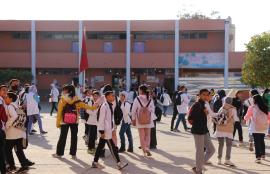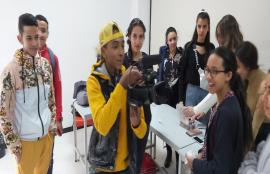- Days
- Hours
- Minutes
- Seconds
Project « Education and Training for Employability »
Secondary Education
The "Secondary education" activity, with a budget of $114.3 million, aims to improve the quality and relevance of…
Read more...Employment
The "Employment" activity, with a budget of some $24,7 million, aims to improve labour market observation and…
Read more...Vocational Training
The "vocational training" activity, with a budget of some $87.3 million, aims to develop and improve…
Read more...
Issue:
The low quality of human capital represents a major constraint to economic growth in Morocco. This weakness is reflected in a low academic success rate, a tendency of students to choose fields of study that do not meet the needs of companies and gaps in the achievements and skills of the graduates. Private sector companies operating in these sectors state that candidates applying for vacancies do not have the fundamental skills acquired at secondary school level (soft-skills, fluency in foreign languages as well as technical knowledge). Even for the most sophisticated jobs, companies cannot find the right profiles with the necessary skills.
Goal :
The “Education and training for employability” project, with a budget of $ 220 million, aims to strengthen the employability of young people by improving the quality and relevance of secondary education and technical and vocational education and training (TVET) programs and the equitable access to these programs in order to better meet the needs of the productive sector.
Consistency:
This project is structured around three activities, namely
- "Secondary Education"
- "Technical and Vocational Education and Training"
- "Employment"
* The "Secondary Education" activity ($ 111.4 million) has three fundamental components:
- The establishment of an Integrated School Improvement Model, called the “Lycée Attahadi'' model, based on strengthening the administrative and financial autonomy of schools, promoting student-centered pedagogy as well as improving the overall physical learning environment. This component is deployed in 90 secondary schools, spread over three regions (Tangier-Tétouan-Al Hoceïma, Fez-Meknes and Marrakech-Safi). To strengthen and sustain the interventions planned under this component, an “Education for Employability Partnership Fund” co-finances innovative activities that contribute to the improvement of learning, through the establishment of partnerships between civil society, the private sector and schools;
- Strengthening the Student Learning Assessment System and of the Education Management Information System "MASSAR";
- The development of a new approach for the School Infrastructure and Equipment Operations and Maintenance.
* The “Technical and Vocational Education and Training” TVET activity ($ 80.42 million) is structured around two components:
- The establishment of the “Charaka” Fund dedicated to support financing the creation or extension of TVET centers managed within the framework of public-private partnership (PPP), or the reconversion of existing public TVET centers from a classic state-led management model into a model driven by private sector demand and managed through a PPP;
- The support to the operationalization of the TVET Sector Reform.
* The “Employment” activity ($ 27 million) covers four components:
- Support to the improvement and integration of the labor market observation system;
- The promotion of inclusive employment for people facing difficulties entering the labor market, especially women, non-graduates and graduates of higher education or TVET in a situation of long-term unemployment, through a Results-Based Financing (RBF) of services and support programs for their insertion;
- Support for the impact assessment of employment and labor market policies;
- Support for the promotion of gender equity in the workplace.





